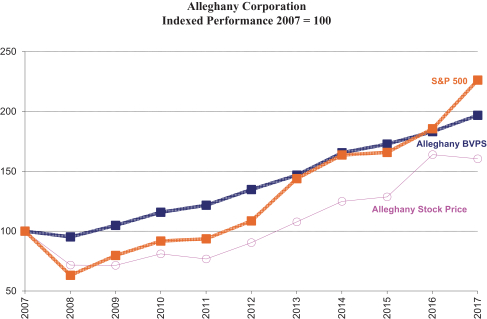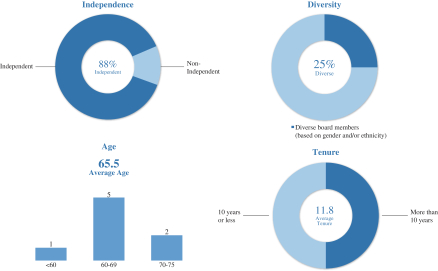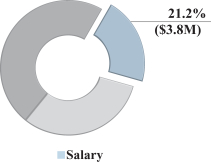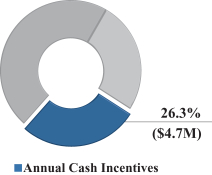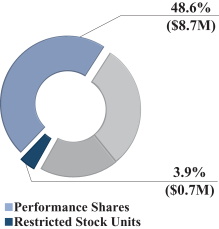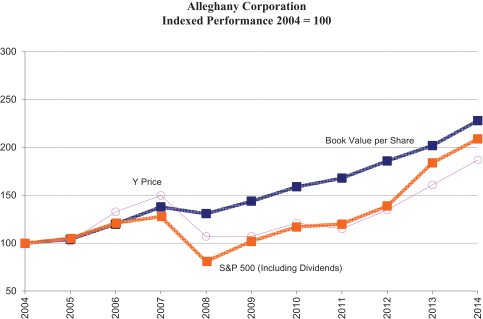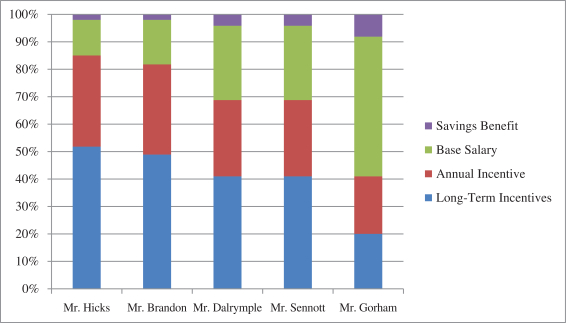EXHIBIT A
ALLEGHANY CORPORATION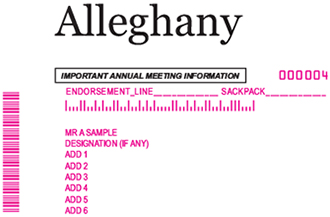
2015 DIRECTORS’ STOCK PLAN
1. PURPOSE. This Alleghany Corporation 2015 Directors’ Stock Plan (the “Plan”) has been adopted by the Board of Directors (the “Board”) of Alleghany Corporation (the “Company”). The purpose of the Plan is to advance the interests of the Company and its stockholders by attracting and retaining highly qualified individuals to serve as members of the Board who are not employees of the Company or any of its subsidiaries, and to encourage them to increase their stock ownership in order to promote long-term stockholder value through ownership of the common stock, $1.00 par value, of the Company (“Common Stock”). The purpose of the Plan will be accomplished through the grant of shares of Common Stock subject to the potential forfeiture and restrictions on transfer in Section 4 (“Restricted Stock”) or notional units of measurement, each equivalent to one share of Common Stock (“Restricted Stock Units”) or any combination thereof pursuant to the terms hereof.
2. ADMINISTRATION. The Plan shall be administered by the Board or a duly appointed committee thereof. The Board shall have all the powers vested in it by the terms of the Plan, such powers to include, without limitation, the authority (within the limitations described herein) to construe the Plan, to determine all questions arising thereunder and, subject to the provisions of the Plan, to adopt and amend such rules and regulations for the administration of the Plan as it may deem desirable. Any decision of the Board in the administration of the Plan shall be final and conclusive. The Board may authorize any one or more of its members or any officer of the Company to exercise the Board’s power over the day-to-day administration of the Plan, including executing and delivering documents on behalf of the Company.
3. ANNUAL EQUITY GRANTS. Each year, as of the first business day following the conclusion of the Company’s annual meeting of stockholders (the “Annual Meeting”), each individual who was elected, reelected or continues as a member of the Board and who is not an employee of the Company or any subsidiary (a “Non-Employee Director”) shall automatically be granted either (x) such number of shares of Restricted Stock equal to $130,000 (or such higher amount as shall be determined by the Board from time to time) divided by the 30-Day Average Value (as defined below) of one share of Common Stock on the grant date or (y) if elected by the Non-Employee Director in accordance with Section 5(a), such number of Restricted Stock Units equal to $130,000 (or such higher amount as shall be determined by the Board from time to time) divided by the 30-Day Average Value of one share of Common Stock on the grant date, subject to payment as provided in Section 5. “30-Day Average Value” shall mean, with respect to any date, the average of the closing sales prices of the Common Stock on the 30 consecutive trading days preceding the grant date as reported on the stock exchange or market on which the Common Stock is primarily traded. In the event that an individual is appointed as a member of the Board after an Annual Meeting and at such time is a Non-Employee Director (an “Appointed Director”), such Appointed Director shall automatically be granted Restricted Stock (or if elected by such Appointed Director as provided herein, Restricted Stock Units) as of the date he is appointed to the Board (the “Appointment Date”), as to that number of whole shares of Restricted Stock or Restricted Stock Units (with any fractional share rounded up) as is equal to (a) the number of shares of Restricted Stock or Restricted Stock Units that would have been granted pursuant to the applicable award that the Appointed Director would have received had he been elected at the immediately preceding Annual Meeting (as such number was adjusted pursuant to Section 7 hereof since the immediately preceding Annual Meeting), times (b) the ratio which the number of days from the Appointment Date until the next Annual Meeting bears to 365.
4. RESTRICTED STOCK.
(a) Restricted Stock granted under the Plan shall be issued for no consideration, but the Restricted Stock shall be forfeited to the Company (without the payment of any consideration) if the Non-Employee Director resigns from the Board prior to the Next Annual Meeting. In the event that a Non-Employee Director previously granted Restricted Stock shall terminate service as a Non-Employee director due to
death or disability prior to the vesting thereof, the Board may in its sole discretion determine to vest such shares of Restricted Stock, in full or in part. In addition, Restricted Stock shall not be sold, assigned, pledged or transferred to any person until the third anniversary of the date the Restricted Stock is granted or, in the case of Restricted Stock granted to an Appointed Director upon his appointment, the third anniversary of the first business day that followed the Annual Meeting immediately preceding his appointment; provided that, in any case, the Restricted Stock shall automatically cease to be subject to the foregoing restrictions on sale, assignment, pledge or transfer upon the Non-Employee Director’s death prior to the Next Annual Meeting or, subsequent to the Next Annual Meeting, upon the date the Non-Employee Director ceases to be a director for any reason. Notwithstanding anything contained herein to the contrary, upon a Change in Control of the Company (as defined below), all restrictions on sale, assignment, pledge or transfer on shares of Restricted Stock (or shares that were previously Restricted Stock) shall lapse and be of no further force or effect.
(b) The Non-Employee Director to whom Restricted Stock is issued will have the customary rights of a stockholder with respect to such shares of Common Stock, including the right to vote the shares of Common Stock and to receive dividends paid thereon. Prior to the date the Restricted Stock ceases to be subject to the restrictions on sale, assignment, pledge or transfer in Section 4(a), dividends paid on such Common Stock in the form of additional shares of Common Stock or as securities or other property shall be subject to the same risk of forfeiture and other restrictions as the underlying shares of Common Stock with respect to which the dividend was paid.
(c) Any Restricted Stock issued under the Plan may be evidenced in such manner as the Board in its sole discretion shall deem appropriate, including, without limitation, book-entry registration or by the issuance of a stock certificate or certificates. In the event any stock certificate is issued in respect of Restricted Stock, such certificate shall be registered in the name of the Non-Employee Director, and shall bear an appropriate legend referring to the terms, conditions, and restrictions applicable to such Restricted Stock.
5. RESTRICTED STOCK UNITS.
(a) To elect to be granted Restricted Stock Units in lieu of the automatic grant of Restricted Stock, a Non-Employee Director must affirmatively elect (an “Election”) to receive such Restricted Stock Units on or before the December 31st preceding the Annual Meeting in respect of which the automatic grant of Restricted Stock would otherwise be made; provided, however, that (i) a Non-Employee Director who is newly elected as a director at an Annual Meeting may make his Election before the date of such Annual Meeting at which the Non-Employee Director was first elected as a director and (ii) an Appointed Director may make his Election with respect to (x) the grant of Restricted Stock to be received at the next Annual Meeting on or before the later of (A) the date of the meeting of the Board at which he was appointed as a director or (B) the December 31st preceding that next Annual Meeting, and (y) the Restricted Stock to be received upon his appointment as a director, on or before the date of the meeting of the Board at which he was appointed as a director. Each Election shall be irrevocable after the last date that such Election may be made. Each Election to receive Restricted Stock Units may also include an election specifying the date or dates and/or event or events for the payment in respect of such Restricted Stock Units (each such date or dates and/or event or events being referred to herein as a “Payment Date”); provided that any Payment Date elected may not specify a date or event for payment that is prior to the third anniversary of the date such Restricted Stock Units are granted or, in the case of Restricted Stock Units granted to an Appointed Director upon his appointment, prior to the third anniversary of the first business day that followed the Annual Meeting that immediately preceded his appointment (in either case, other than a Payment Date that provides for payment when the Non-Employee Director ceases to be a member of the Board). Each Payment Date: (i) specified as a calendar date must be January 1st and (ii) specified as an event shall be deemed to be the January 1st coinciding with or next following the specified event. A Non-Employee Director’s Election may provide that such Election shall remain in effect until revoked (which revocation must be made on or before the December 31st preceding the Annual Meeting at which such revocation is to take effect) with respect to all subsequently granted Restricted Stock Units.
(b) The Company shall establish and maintain a separate unfunded, bookkeeping account to which the Restricted Stock Units granted to a Non-Employee Director shall be credited (an “Account”), which Account shall reflect the investment experience that the Account would have had if such Account held whole or fractional shares of Common Stock equal to the number of whole or fractional Restricted Stock Units credited to the Account. A separate sub-Account shall be created to identify each grant of Restricted Stock Units for purposes of applying the provisions of the Plan. The Account (and each sub-Account) shall exist solely for record keeping purposes and shall not represent any actual interest in any shares of Common Stock. The right of any Non-Employee Director to receive payments in respect of Restricted Stock Units shall be no greater than the right of any unsecured general creditor of the Company. If any cash or stock dividends are paid on the shares of Common Stock represented by the Restricted Stock Units during the period between the date such Restricted Stock Units are granted and the Payment Date with respect to such Restricted Stock Units, then additional whole or fractional Restricted Stock Units shall be credited to the Non-Employee Director’s Account. Such credit shall be made as of the applicable dividend payment date. The number of whole or fractional Restricted Stock Units credited as a result of any cash dividends shall be determined by dividing (a) the aggregate dollar amount of the cash dividends by (b) the Fair Market Value of a share of Common Stock on the dividend payment date. For purposes of the Plan, Fair Market Value is the closing sales prices of the Common Stock on the relevant date as reported on the stock exchange or market on which the Common Stock is primarily traded, or, if no sale is made on such date, then Fair Market Value is the weighted average of the closing sales prices of the Common Stock on the next preceding day and the next succeeding day on which such sales were made as reported on the stock exchange or market on which the Common Stock is primarily traded. The additional whole and/or fractional Restricted Stock Units acquired with any cash or stock dividends shall be payable at the same time as the Restricted Stock Units representing the shares of Common Stock giving rise to the dividends. Notwithstanding anything contained herein or in any Election or Amended Election (as hereinafter defined) made by a Non-Employee Director to the contrary, if a Non-Employee Director resigns prior to the Next Annual Meeting following the date the Restricted Stock Units were granted, such Restricted Stock Units shall be forfeited. In the event that a Non-Employee Director previously awarded or granted Restricted Stock Units shall terminate service as a Non-Employee director due to death or disability prior to the vesting thereof, the Board may in its sole discretion determine to vest such Restricted Stock Units, in full or in part, with settlement of such vested Restricted Stock Units to be determined in accordance with the Non-Employee Director’s Election. Notwithstanding anything contained herein to the contrary, upon a Change in Control of the Company, all restrictions on sale, assignment, pledge or transfer on shares underlying Restricted Stock Units shall lapse and be of no further force or effect.
(c) All payments in respect of whole Restricted Stock Units shall be made in the form of whole shares of Common Stock and any fractional Restricted Stock Unit shall be paid in cash based upon the Fair Market Value of the equivalent fraction of a share of Common Stock. Unless a Non-Employee Director’s Election provides otherwise, the Payment Date in respect of the Restricted Stock Units credited to a Non-Employee Director’s Account shall be the date that is the third anniversary of the date such Restricted Stock Units were granted or, in the case of Restricted Stock Units granted to an Appointed Director upon his appointment, the date that is the third anniversary of the first business day that followed the Annual Meeting that immediately preceded his appointment. Notwithstanding the foregoing or any Election or Amended Election made by a Non-Employee Director, if a Non-Employee Director dies, all Restricted Stock Units remaining in the Non-Employee Director’s Account shall be paid to the individual or entity designated by the Non-Employee Director in writing and filed with the Company (and if the Non-Employee Director did not designate a beneficiary or such designated beneficiary predeceases the Non-Employee Director, the Non-Employee Director’s beneficiary shall be the Non-Employee Director’s spouse, if any, or if none, his/her estate). All payments in respect of Restricted Stock Units shall be made as promptly as possible following the Payment Date and in any event, on or before the last day of the calendar year in which the Payment Date occurs.
(d) At least twelve months prior to the Payment Date with respect to any Restricted Stock Units, a Non-Employee Director may elect (an “Amended Election”) to defer distribution of all or any number of such Restricted Stock Units credited to his/her Account to a date occurring after the original Payment Date; provided, however, that (a) such Amended Election will not take effect for at least 12 months after the date on which it is made and (b) the distribution in respect of the Restricted Stock Units with respect to which the Amended Election is made must be at least 5 years from the original Payment Date. A Non-Employee Director’s Amended Election may otherwise provide for distribution at any time as could have been elected under an original Election.
(e) All Elections and Amended Elections shall be in writing and shall be effective on and when received by the Company pursuant to procedures established by the Board from time to time. An Amended Election when received pursuant to such procedures is irrevocable when received.
(f) No Restricted Stock Units shall be pledged, encumbered, or hypothecated to, or in favor of, or subject to any lien, obligation, or liability of a Non-Employee Director to, any party, nor shall any Restricted Stock Units be assignable or transferable by the recipient thereof.
6. AVAILABLE SHARES OF COMMON STOCK. There may be issued under the Plan as Restricted Stock or as Restricted Stock Units granted in lieu of Restricted Stock, including any Restricted Stock or Restricted Stock Units in respect of dividends thereon an aggregate of not more than 60,000 shares of Common Stock, subject to adjustment as provided in Section 7.
7. DILUTION AND OTHER ADJUSTMENTS. In the event of any corporate transaction involving the Company (including, without limitation, any subdivision or combination or exchange of the outstanding shares of Common Stock, stock dividend, stock split, spin-off, split-off, recapitalization, capital reorganization, liquidation, reclassification of shares of Common Stock, merger, consolidation, extraordinary cash distribution, or sale, lease or transfer of substantially all of the assets of the Company), the number or kind of shares or other property (including cash) that may be issued or delivered under the Plan, the number of Restricted Stock and Restricted Stock Units annually granted pursuant to Section 3 and granted in the aggregate under Section 6 shall be automatically adjusted, in the manner determined by the Board in its sole discretion, to give effect to the occurrence of such event so that the proportionate interest of the Non-Employee Director (and any person succeeding to such Non-Employee Director’s rights pursuant to the Plan) shall be maintained as before the occurrence of such event, and such adjustment shall be conclusive and binding for all purposes of the Plan.
8. AMENDMENT OR TERMINATION. The Board, without the consent of any Non-Employee Director, may at any time terminate or from time to time amend the Plan in whole or in part, including, without limitation, to increase or decrease the number of shares of Common Stock granted as Restricted Stock or as Restricted Stock Units in Section 3; provided, however, that no such action shall adversely affect any rights or obligations with respect to Restricted Stock or Restricted Stock Units previously granted under the Plan; and provided, further, that no amendment, without further approval by the stockholders of the Company in accordance with Section 10 below, shall (i) increase the aggregate number of shares subject to the Plan (other than increases pursuant to Section 7), (ii) extend the period during which Restricted Stock or Restricted Stock Units may be granted under the Plan as set forth in Section 10, or (iii) modify the requirements for eligibility to participate in the Plan.
9. MISCELLANEOUS PROVISIONS.
(a) Nothing in the Plan shall be deemed to create any obligation on the part of the Board to nominate any director for re-election by the Company’s stockholders or to limit the rights of the stockholders to remove any director. Except as expressly provided for in the Plan, no Non-Employee Director or other person shall have any claim or right to be granted Restricted Stock or Restricted Stock Units under the Plan.
(b) The Company shall have the right to require, prior to the issuance of any shares of Common Stock pursuant to the Plan, the payment of, or provision by, a Non-Employee Director of any taxes required by
law to be withheld with respect to the issuance of such shares or otherwise. The Board shall be authorized to establish procedures for elections by Non-Employee Directors to satisfy such withholding taxes by delivery of, or directing the Company to retain, shares of Common Stock.
(c) The obligation of the Company to issue shares of Common Stock as Restricted Stock or in settlement of Restricted Stock Units shall be subject to the satisfaction of all applicable legal and securities exchange requirements, including, without limitation, the provisions of the Securities Act of 1933, as amended, and the Securities Exchange Act of 1934, as amended. The Company shall endeavor to satisfy all such requirements in such a manner as to permit at all times the issuance and delivery of shares of Common Stock as Restricted Stock and in settlement of Restricted Stock Units.
(d) No shares of Common Stock shall be issued hereunder unless counsel for the Company shall be satisfied that such issuance will be in compliance with applicable federal, state and other securities laws.
(e) Shares of Common Stock issued under the Plan may be original issue shares of Common Stock, treasury stock, shares of Common Stock purchased in the open market or otherwise.
(f) The Plan is intended to be operated in compliance with Section 409A of the Internal Revenue Code of 1986, as amended (“Section 409A”). If any provision of the Plan is subject to more than one interpretation, then the Plan shall be interpreted in a manner that is consistent with Section 409A.
10. EFFECTIVE DATE; TERM. The Plan is effective when approved by the Company’s stockholders at the annual meeting of stockholders held in the 2015 calendar year by an affirmative vote of a majority of the votes cast on the proposal at such meeting. The Plan shall terminate immediately preceding the seventh annual meeting of stockholders following the annual meeting at which the Plan becomes effective, unless sooner terminated by action of the Board. No Restricted Stock or Restricted Stock Unit may be granted hereunder after termination of the Plan, but such termination shall not affect the validity of any Restricted Stock or Restricted Stock Unit theretofore granted.
11. LAW GOVERNING. The validity and construction of the Plan and any agreements entered into thereunder shall be governed by the laws of the State of Delaware, but without regard to the conflict laws of the State of Delaware.
12. DEFINITION OF CHANGE IN CONTROL. For purposes of the Plan, a “Change in Control” of the Company shall mean the occurrence of any of the following events:
(a) Any individual, entity or group (within the meaning of Section 13(d)(3) or 14(d)(2) of the Securities Exchange Act of 1934, as amended (the “Exchange Act”)) (a “Person”) becomes the beneficial owner (within the meaning of Rule 13d-3 promulgated under the Exchange Act) of 50% or more of either (i) the then-outstanding shares of Common Stock (the “Outstanding Company Common Stock”) or (ii) the combined voting power of the then-outstanding voting securities of the Company entitled to vote generally in the election of directors (the “Outstanding Company Voting Securities”);provided,however, that, for purposes of this Section 12(a), the following acquisitions shall not constitute a Change in Control: (A) any acquisition directly from the Company; (B) any acquisition by the Company; (C) any acquisition by any employee benefit plan (or related trust) sponsored or maintained by the Company or any of its affiliates or subsidiaries or (D) any acquisition pursuant to a transaction that complies with Sections 12(c)(i), (ii) and (iii);
(b) Any time at which individuals who, as of the date immediately following the date of stockholder approval of the Plan, constitute the Board (the “Incumbent Board”) cease for any reason to constitute at least a majority of the Board;provided,however, that any individual becoming a director subsequent to the date immediately following the date of stockholder approval of the Plan whose election, or nomination for election by the Company’s stockholders, was approved by a vote of at least a majority of the directors then comprising the Incumbent Board shall be considered as though such individual were a member of the Incumbent Board, but excluding, for this purpose, any such individual whose initial assumption of office
occurs as a result of an actual or threatened election contest with respect to the election or removal of directors or other actual or threatened solicitation of proxies or consents by or on behalf of a Person other than the Board;
(c) Consummation of a reorganization, merger, statutory share exchange or consolidation or similar transaction involving the Company or any of its subsidiaries, a sale or other disposition of all or substantially all of the assets of the Company, or the acquisition of assets or stock of another entity by the Company or any of its Subsidiaries (each, a “Business Combination”), in each case unless, following such Business Combination, (i) all or substantially all of the individuals and entities that were the beneficial owners of the Outstanding Company Common Stock and the Outstanding Company Voting Securities immediately prior to such Business Combination beneficially own, directly or indirectly, more than 50% of the then-outstanding shares of common stock (or, for a non-corporate entity, equivalent securities) and the combined voting power of the then-outstanding voting securities entitled to vote generally in the election of directors (or, for a non-corporate entity, equivalent governing body), as the case may be, of the entity resulting from such Business Combination (including, without limitation, an entity that, as a result of such transaction, owns the Company or all or substantially all of the Company’s assets either directly or through one or more subsidiaries) in substantially the same proportions as their ownership immediately prior to such Business Combination of the Outstanding Company Common Stock and the Outstanding Company Voting Securities, as the case may be, (ii) no Person (excluding any corporation resulting from such Business Combination or any employee benefit plan (or related trust) of the Company or such corporation resulting from such Business Combination) beneficially owns, directly or indirectly, 50% or more of the then-outstanding shares of common stock of the corporation resulting from such Business Combination or the combined voting power of the then-outstanding voting securities of such corporation, except to the extent that such ownership existed prior to the Business Combination, and (iii) individuals who were members of the Incumbent Board at the time of the execution of the initial agreement or of the action of the Board providing for such Business Combination constitute at least a majority of the members of the board of directors (or, for a non-corporate entity, equivalent governing body) of the entity resulting from such Business Combination; or
(d) Approval by the stockholders of the Company of a complete liquidation or dissolution of the Company.
EXHIBIT B
ALLEGHANY CORPORATION
2015 MANAGEMENT INCENTIVE PLAN
1. PURPOSE OF THE PLAN. The purpose of the Alleghany Corporation 2015 Management Incentive Plan (the “Plan”) is to allow Alleghany Corporation (the “Company”) to provide incentive compensation bonuses (“Incentive Bonuses”) to its officers, upon whom, in large measure, the sustained progress, growth and profitability of the Company depends. The Plan provides for the award of both Incentive Bonuses that are intended to satisfy the requirements for performance-based compensation (“Qualifying Incentives”) in Section 162(m) of the Internal Revenue Code of 1986, as amended, and the regulations thereunder (the “Code”), and Incentive Bonuses that are not intended to satisfy such requirements (“Non-Qualifying Incentives”).
2. ADMINISTRATION OF THE PLAN. The Plan shall be administered by the Compensation Committee of the Board of Directors of the Company (the “Committee”). Subject to the provisions of the Plan, the Committee shall have the exclusive authority to (i) select the officers to participate in the Plan, (ii) establish performance goals for Incentive Bonuses, including without limitation, any target, threshold or other level of performance that must be achieved to earn an Incentive Bonus, (iii) determine whether Incentive Bonuses will be Qualifying Incentives or Non-Qualifying Incentives, (iv) establish each Participant’s Incentive Bonus opportunity (or range thereof), (v) determine the amount of the Incentive Bonus payable to any Participant, and (vi) make all other determinations and take all other actions necessary or appropriate for the proper administration and operation of the Plan. Any determination by the Committee on any matter relating to the Plan shall be made in its sole discretion and need not be uniform among Participants. The Committee’s interpretation of the Plan shall be final, conclusive and binding on all parties concerned, including the Company, its stockholders and any Participant.
3. ELIGIBILITY. Incentive Bonuses under the Plan may be paid to those officers (including officers who are directors) of the Company who shall be selected by the Committee to participate in the Plan after consideration of management’s recommendations (the “Participants”). Participants may receive multiple Incentive Bonuses during the same year under the Plan.
4. PERFORMANCE PERIODS. Qualifying Incentives shall be payable to a Participant as a result of the satisfaction of performance goals in respect of the calendar year or such other period, not to be less than six months, as is selected by the Committee (a “Performance Period”). Non-Qualifying Incentives may be payable to a Participant as a result of the satisfaction of performance goals in respect of a Performance Period or as a result of the achievement of an individual objective or result, as determined by the Committee in its sole discretion.
5. INCENTIVE BONUSES.
(a)Incentive Bonuses. The Committee, in its sole discretion, may grant Incentive Bonuses to any Participant, which Incentive Bonuses may be Qualifying Incentives or Non-Qualifying Incentives. A Participant may be granted one or more Qualifying Incentives or Non-Qualifying Incentives in respect of the same Performance Period and may be granted both Qualifying Incentives and Non-Qualifying Incentives at the same time or in respect of the same Performance Period. Notwithstanding the foregoing, the grant or payment of any Non-Qualifying Incentive shall not be made contingent on the failure to earn any Qualifying Incentive.
(b)Qualifying Incentives. Incentive Bonuses granted to any Participant who is a “covered employee” (as defined in Section 162(m) of the Code) for that Performance Period shall be a Qualifying Incentive unless otherwise determined by the Committee in its sole discretion. The right to receive (or retain) any Qualifying Incentive shall be conditional upon the achievement of one or more performance goals established by the Committee in writing at the time such award is granted. Prior to the beginning of each Performance Period, or at such other time no later than such time as is permitted by Section 162(m) of the Code, the Committee shall establish in writing (i) the performance goal or goals (as described in Section 5(c)), upon which a Participant’s Qualifying Incentive shall be based and (ii) after consideration of
management’s recommendations, the target (or range of) Qualifying Incentive opportunity for each Participant based upon the attainment of such performance goal or goals. The Committee may provide for a threshold level of performance below which no amount of a Qualifying Incentive will be paid and a maximum level of performance above which no additional Qualifying Incentive will be paid, and it may provide for the payment of differing amounts for different levels of performance. The Committee may provide that a Qualifying Incentive shall be determined as an amount or a percentage of a specified incentive pool based upon operating income, cash flow, earnings before income taxes, net income or other measures constituting a performance goal (as described in Section 5(c)), with such adjustments or exclusions as the Committee may determine; provided, however, that if the payment to a Participant of the Qualifying Incentive is based upon the attainment of one or more performance goals (as described in Section 5(c)) established by the Committee, the Committee may determine the amount of the incentive pool by reference to any measure (whether or not constituting a performance goal as described in Section 5(c)) as the Committee deems appropriate. The total amount or percentage of the incentive pool awarded to Participants shall not exceed 100% of the incentive pool, and the amount paid to any Participant from such incentive pool shall not be increased by any amount not paid to any other Participant.
(c)Qualifying Incentive Performance Goals. Performance goals, which may vary from Participant to Participant and from Qualifying Incentive opportunity to Qualifying Incentive opportunity, shall be based upon the attainment of specific amounts or percentages of, or increases or decreases in, one or more of the following: revenues; operating income; net operating income; cash flow; earnings before income taxes; net income; earnings per share; stockholders’ equity; return or net return on assets or net assets, investments, capital or equity; share price; share price appreciation; underwriting profits; gross or net premiums written; net premiums earned; compound growth in net loss and loss adjustment expense reserves; loss ratio or combined ratio of the Company’s insurance businesses; operating efficiency or strategic business objectives consisting of one or more objectives based on meeting specified cost targets; business expansion goals; goals relating to acquisitions or divestitures; and productivity improvements, all whether applicable to the Company or any relevant subsidiary or business unit or entity in which the Company has a significant investment, or any combination thereof as the Committee may deem appropriate.
Each performance goal may be expressed on an absolute and/or relative basis, may be based on, or otherwise employ, comparisons based on internal targets, the past performance of the Company or any subsidiary (or any business unit thereof) and/or the past or current performance of other companies or indexes, may provide for the inclusion, exclusion or averaging of specified items in whole or in part, including without limitation, catastrophe losses, realized gains or losses on strategic investments, acquisitions and divestitures, currency fluctuations, discontinued operations, extraordinary items whether of income or expense, accounting and tax changes, and any unusual or nonrecurring items, and, in the case of earnings-based measures, may use or employ comparisons relating to capital, shareholders’ equity and/or shares outstanding, assets or net assets.
(d)Qualifying Incentive Determination. As soon as practicable after the end of each Performance Period but before any Qualifying Incentives are paid, the Committee shall certify in writing (i) whether the performance goal or goals were attained and (ii) the amount of the Qualifying Incentive payable to each Participant based upon the attainment of the performance goal or goals established by the Committee. The Committee may determine to grant a Participant a Qualifying Incentive equal to, but not in excess of, the amount specified in the foregoing certification. The Committee may also reduce or eliminate the amount of any Qualifying Incentive of any Participant at any time prior to payment thereof, based on such criteria as it shall determine, including but not limited to individual merit and attainment of, or the failure to attain, specified personal goals established by the Committee. Under no circumstances may the Committee increase the amount of the Qualifying Incentive otherwise payable to a Participant beyond the amount originally established, waive the attainment of the performance goals established by the Committee for purposes of qualifying and Incentive Bonus as a Qualifying Incentive under Section 162(m) of the Code or otherwise exercise its discretion so as to cause any Qualifying Incentive not to qualify as performance-based compensation under Section 162(m) of the Code.
(e)Non-Qualifying Incentives. A Non-Qualifying Incentive may be awarded by the Committee to any Participant (including covered employees) at any time before, during or following the completion of any Performance Period and may, but need not, be conditioned upon the achievement of any performance goals established by the Committee. The Committee may increase, decrease or eliminate the amount of any Non-Qualifying Incentive awarded to any Participant at any time prior to payment thereof, based on such criteria as it shall determine, including but not limited to individual merit and attainment of, or the failure to attain or achieve, any performance goals or specified personal goals established by the Committee or management, and the Committee may waive the attainment of or modify the terms of any performance or personal goals established by the Committee or management or otherwise exercise its discretion in any manner with respect to any Non-Qualifying Incentive.
6. OTHER TERMS OF INCENTIVE BONUSES
(a)Death or Disability. In the event that a Participant previously awarded or granted an Incentive Bonus shall die or become disabled prior to the completion of the Performance Period with respect to such Incentive Bonus, the Participant (or in the event of the Participant’s death, the Participant’s beneficiary) shall be entitled to receive such amount, if any, of the Incentive Bonus granted or awarded to the Participant as shall be determined by the Committee in its sole discretion. Nothing contained herein shall preclude the Committee, in its sole discretion, from granting a Non-Qualifying Incentive to any Participant in respect of the Participant’s employment by the Company prior to such Participant’s death or disability.
(b)Other Terminations of Employment. If a Participant’s employment terminates prior to the end of a Performance Period for any reason other than death or disability, the Participant shall not be entitled to receive any Qualifying Incentive established for the Participant; provided, however, that if the performance goals applicable to such Qualifying Incentive are achieved and certified by the Committee (in accordance with Section 5(d)), the Committee, in its discretion, may determine that the Participant shall be entitled to receive all or any part of the Qualifying Incentive that would be payable to the Participant based upon the achievement of those performance goals. If a Participant previously granted a Non-Qualifying Incentive terminates employment for any reason (other than death or disability), the Committee, in its sole discretion, may determine that such Participant is entitled to receive payment of all or any portion of such Non-Qualifying Incentive.
(c)Payment. As soon as practicable following the Committee’s determination of the amount of any Qualifying Incentive payable to a Participant (in accordance with Section 5(d)), but no later than March 15th of such year, such Qualifying Incentive shall be paid by the Company in cash to such Participant. A Non-Qualifying Incentive shall be paid in cash promptly (and in any event within two and one-half months) following the date for payment specified by the Committee at the time a Non-Qualifying Incentive is granted. Notwithstanding the foregoing, if the Committee, in its sole discretion, determines that a Participant who died or became disabled shall be entitled to receive an Incentive Bonus, then such Incentive Bonus shall be paid to such Participant (or in the event of the Participant’s death, the Participant’s beneficiary) in cash promptly following the date for payment specified by the Committee at the time the Incentive Bonus is determined by the Committee, but in no event later than March 15th of the year following the year in which such death or disability occurred. Nothing contained in this Plan shall require the acceleration of the time of payment of any Incentive Bonus that the Participant has elected to defer under any deferred compensation plan or arrangement of the Company.
(d)Annual Maximum. The Qualifying Incentives, individually or in the aggregate, that could be payable to any Participant pursuant to the Plan in any single calendar year shall not exceed $5 million.
7. DILUTION AND OTHER ADJUSTMENTS.
To the extent that a performance goal is based on, or calculated with respect to, the Company’s common stock (such as earnings per share, book value per share or other similar measures), then in the event of any corporate transaction involving the Company (including, without limitation, any subdivision or combination or
exchange of the outstanding shares of common stock, stock dividend, stock split, spin-off, split-off, recapitalization, capital reorganization, liquidation, reclassification of shares of common stock, merger, consolidation, extraordinary cash distribution, or sale, lease or transfer of substantially all of the assets of the Company), the Committee shall make or provide for such adjustments in such performance goal as the Committee may in good faith determine to be equitably required in order to prevent dilution or enlargement of the rights of Participants.
8. MISCELLANEOUS PROVISIONS.
(a)No Right to Incentive Bonus. Notwithstanding anything contained herein to the contrary, no officer or other person shall have any claim or legally binding right to be paid any Incentive Bonus awarded or granted under the Plan prior to the actual payment thereof, and any Participant who terminates employment (other than due to death or disability) prior to the payment of an Incentive Bonus shall forfeit any right to receive such Incentive Bonus, regardless of the terms of any award or grant or any prior determination by the Committee.
(b)No Assurance of Employment. Neither the establishment of the Plan nor any action taken thereunder shall be construed as giving any officer or other person any right to be retained in the employ of the Company.
(c)Withholding Taxes. The Company shall have the right to deduct from all Incentive Bonuses payable hereunder any federal, state, local or foreign taxes required by law to be withheld with respect to such payments.
(d)No Transfers or Assignments. No Incentive Bonus under the Plan nor any rights or interests herein or therein shall be assigned, transferred, pledged, encumbered, or hypothecated to, or in favor of, or subject to any lien, obligation, or liability of a Participant to, any party (other than the Company or any subsidiary), except, in the event of the Participant’s death, to his designated beneficiary as hereinafter provided.
(e)Beneficiary. Any payments on account of an Incentive Bonus payable under the Plan to a deceased Participant shall be paid to such beneficiary as has been designated by the Participant in writing to the Secretary of the Company or in the absence of such designation, according to the Participant’s will or the laws of descent and distribution.
(f)Non-exclusivity of Plan. Nothing in the Plan shall be construed in any way as limiting the authority of the Committee, the Board of Directors of the Company, the Company or any subsidiary to establish any other annual or other incentive compensation plan or as limiting the authority of any of the foregoing to pay cash bonuses or other supplemental or additional incentive compensation to any persons employed by the Company, whether or not such person is a Participant in this Plan and regardless of how the amount of such bonus or compensation is determined.
9. AMENDMENT OR TERMINATION OF THE PLAN. The Board of Directors of the Company, without the consent of any Participant, may at any time terminate or from time to time amend the Plan in whole or in part, whether prospectively or retroactively, including in any manner that adversely affects the rights of Participants; provided, however, that no amendment with respect to the terms of the Plan relating to the ability to grant awards that constitute, or affect, Qualifying Incentives that would require the approval of the stockholders of the Company pursuant to Section 162(m) of the Code shall be effective without such approval.
10. LAW GOVERNING. The validity and construction of the Plan shall be governed by the laws of the State of Delaware, but without regard to the conflict laws of the State of Delaware.
11. EFFECTIVE DATE. The Plan shall be effective when approved by the stockholders of the Company in accordance with Section 162(m) of the Code.
| | |
ALLEGHANY CORPORATION
|
IMPORTANT ANNUAL MEETING INFORMATION
| | |
| | |
|
|
| Using ablack ink pen, mark your votes with anX as shown in this example. Please do not write outside the designated areas. | | x☒ |
| | |

Electronic Voting Instructions Available 24 hours a day, 7 days a week! Instead of mailing your proxy, you may choose one of the two voting methods outlined below to vote your proxy. |
  | | Vote by Internet |
| | • Go towww.envisionreports.com/YAL. |
| | • Or scan the QR code with your smartphone. |
| | • Follow the steps outlined on the secure website. |
| | Vote by telephone |
| | • Call toll free 1-800-652-VOTE (8683) within the USA, US territories & Canada any time on a touch tone telephone. There isNO CHARGE to you for the call. |
| | • Follow the instructions provided by the recorded message. |
VALIDATION DETAILS ARE LOCATED BELOW IN THE TITLE BAR. |
Proxies submitted by the Internet or telephone must be received by 1:00 a.m., Eastern Daylight Time, on April 24, 2015. 27, 2018. |

|
Alleghany Corporation Annual Meeting Proxy Card
q IF YOU HAVE NOT VOTED VIA THE INTERNETOR TELEPHONE, FOLD ALONG THE PERFORATION, DETACH AND RETURN THE BOTTOM PORTION IN THE ENCLOSED ENVELOPE. q |
q IF YOU HAVE NOT VOTED VIA THE INTERNETOR TELEPHONE, FOLD ALONG THE PERFORATION, DETACH AND RETURN THE BOTTOM PORTION IN THE ENCLOSED ENVELOPE. q
| | |
A | | Proposals — The Board of Directors recommends a voteFOR the listed nominees andFOR Proposals 2, 3, 4 and 5. |
| | | | | | | | | | | | | | | | | | | | | | | | | | |
1. A | | Election of DirectorsProposals — | | | | | | |
| | | | | | | | | | | | | | | | | + |
The Board of Directors recommends a voteFOR the listed nominees andFOR Proposals 2 and 3. | | | | | | | |
| 1. Election of Directors | | For | | Against | | Abstain | | | | For | | Against | | Abstain | | | | | | | | | | + |
| | 1a - John G. Foos | | ¨ | | ¨ | | ¨ | | 1b - William K. Lavin | | ¨ | | ¨ | | ¨ | | | | | | | | | |
| | | | For | | Against | | Abstain | |
1a - William K. Lavin | | For☐ | | Against☐ | | ☐ | | Abstain 1b - Phillip M. Martineau
| | ☐ | | ☐ | | ☐ | | 1c - Raymond L.M. Wong | | ☐ | | ☐ | | ☐ | |
| | | | | | | | | | |
| | 1c - Phillip M. Martineau | | ¨ | | ¨ | | ¨ | | 1d - Raymond L.M. Wong | | ¨ | | ¨ | | ¨ | | | | | | | | | | For | | Against | | Abstain | |
2. Ratification of Independent Registered Public Accounting Firm Ratification of selection of Ernst & Young LLP as Alleghany Corporation’s independent registered public accounting firm for fiscal 2018. | | ☐ | | ☐ | | ☐ | | | | | | | | | | | | | | | | | | | | |
| | | | | | | | | | | | | | | | | | | | For | | Against | | Abstain | | |
3.2.Say-on-Pay | | Approval of 2015 Directors’ Stock Plan
Proposal to approve the Alleghany Corporation 2015 Directors’ Stock Plan.
| | ¨ | | ¨ | | ¨ | | |
| | | | | | | | | | | | | | | | | | | | For
| | Against
| | Abstain
| | |
3. | | Approval of 2015 Management Incentive Plan
Proposal to approve the Alleghany Corporation 2015 Management Incentive Plan.
| | ¨ | | ¨ | | ¨ | | |
| | | | | | | | | | | | | | | | | | | | For
| | Against
| | Abstain
| | |
4. | | Ratification of Independent Registered Public Accounting Firm
Ratification of appointment of Ernst & Young LLP as Alleghany Corporation’s independent registered public accounting firm for fiscal 2015.
| | ¨ | | ¨ | | ¨ | | |
| | | | | | | | | | | | | | | | | | | | For
| | Against
| | Abstain
| | |
5. | | Say-on-Pay
Advisory vote to approve the compensation of the named executive officers of Alleghany Corporation. | | ¨☐ | | ¨☐ | | ¨☐ | | |
| | |
| B | | Authorized Signatures — This section must be completed for your vote to be counted — Date and Sign Below. |
Please sign exactly as your name(s) appear(s) hereon. When signing as attorney, executor, administrator, or other fiduciary, please give full title as such. Joint owners should each sign personally. All holders must sign. If a corporation or partnership, please sign in full corporate or partnership name by authorized officer. |
Please sign exactly as your name(s) appear(s) hereon. When signing as attorney, executor, administrator, or other fiduciary, please give full title as such. Joint owners should each sign personally. All holders must sign. If a corporation or partnership, please sign in full corporate or partnership name by authorized officer.
| | | | |
Date (mm/dd/yyyy) — Please print date below. | | Signature 1 — Please keep signature within the box. | | Signature 2 — Please keep signature within the box. |
| | | | | | | | |
Date (mm/dd/yyyy) — Please print date below. | | | | Signature 1 — Please keep signature within the box. | | | | Signature 2 — Please keep signature within the box. |
| / / | | | | | | | | |
IF VOTING BY MAIL, YOUMUST COMPLETE SECTIONS A - C ON BOTH SIDES OF THIS CARD.
01ZNTC

02IMAE
Important Notice Regarding Internet Availability of Proxy Materials for the Alleghany Corporation 20152018 Annual Meeting of Stockholders to be Held on April 24, 2015.27, 2018.
Our proxy materials relating to our Annual Meeting (Notice of Meeting, Proxy Statement, Proxy and 20142017 Annual Report to Stockholders on Form 10-K) are also available on the Internet. Please go to www.envisionreports.com/YAL to view and obtain proxy materials online.
For comments and/or address changes, please send an email to info2@alleghany.com or call 1.888.752.1356.




